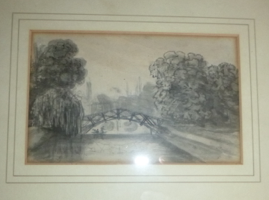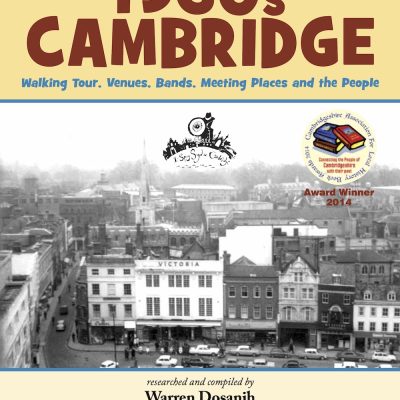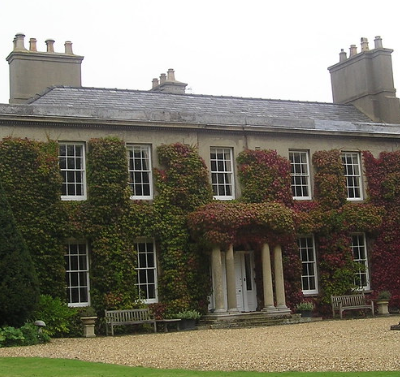Search by topic
- archaeology
- Building of Local Interest
- chapel
- charity
- church
- crime
- dressmaker
- fire
- Great Eastern Railway
- Listed building
- Mapping Relief
- medieval
- oral history
- poverty
- Public House
- Religious House
- Roman
- scholar
- school
- Then and Now
- tudor
- women
- work
- world war one
- world war two
Search by text
 Old Garret Hostel Bridge, painted by the composer William Crotch c.1810
Old Garret Hostel Bridge, painted by the composer William Crotch c.1810Classical composers
Overview of composers with Cambridge link
This is a list of historic and contemporary composers whose birthplace, studies or career, were closely linked to Cambridge:
Robert Fayrfax 1464 – 1521
Fayrfax gained his Mus.B. from Cambridge in 1501 and a Mus.D. in 1504. His mass ‘O Quam Glorifica’ was his doctoral ‘exercise.’
Christopher Tye c.1505 – 1573
Tye is believed to have been born in Cambridgeshire, studied at the University of Cambridge and received his B.Mus. in 1536. In 1537 he became a lay clerk at King’s College. He became master of the choir at Ely Cathedral in 1543 with the annual salary of £10. Cambridge granted him the degree of Doctor of Music in 1545. He was ordained and then became rector of Doddington, at the time the richest benefice in England.
John Amner 1579 – 1641
Amner was born in Ely and had a close association with the cathedral during his life. He received a B.Mus. from Cambridge in 1640.
Orlando Gibbons 1583 -1625
It is now thought that Gibbons was born in Oxford even though he moved at a young age to Cambridge. His father William had became a ‘wait’, a town musician, in Cambridge by 1567, and though the family moved to Oxford, William was back in Cambridge as head of the town waits around 1588. Orlando’s brother Edward was a composer and master of the Choir of King’s College Cambridge and Orlando joined the choir in 1596. Orlando was granted his B.Mus by Cambridge in 1606. It was thought that Gibbons received his music doctorate in 1622 with the qualifying piece, the eight part anthem O Clap Your Hands, but some have disputed this.
John Tomkins 1586 – 1638
Younger brother of celebrated Thomas Tomkins, he was organist of King’s College from 1606-1616.
Gilles Tomkins d 1668
Half brother of celebrated Thomas Tomkins, he was organist of King’s College in 1624.
Benjamin Rogers 1614 – 1698
Rogers obtained the degree of B.Mus from Cambridge in 1658, He wrote music for the city banquet to celebrate the English Restoration of 1660.
Maurice Green 1696 – 1755
He was appointed Professor of Music at Cambridge in 1730. His acknowledged masterpiece is the verse anthem, Lord, let me know mine end.
William Boyce 1711 – 1779
In 1749 he wrote the ode and anthem O be joyful to celebrate the installation of the Duke of Newcastle as Chancellor of Cambridge University, and was awarded the degree of Doctor of Music.
John Randall 1716 – 1799
Graduated B.Bac. at Cambridge in 1744 and was appointed organist to King’s College Chapel the following year. In 1755 he succeeded Maurice Greene as Professor of Music at Cambridge. In 1756 awarded a Mus.Doc. He was assisted by his pupil William Crotch; he died in Cambridge. In 1768 he set to music Thomas Gray’s Ode for the Installation of the Duke of Grafton as Chancellor of the University. In Cambridge in 1794 he published a collection of Psalm and Hymn Tunes.
John Pratt 1772 – 1855 see 62 Jesus Lane. He was born in Cambridge, son of Jonas, musicseller and teacher. In 1780 he became a chorister at King’s College. In 1799 he was appointed successor to Dr Randall at King’s, then University organist, then in 1813 organist of St Peter’s College. His collection of psalms and hymn tunes was called ‘Psalmodia Cantabrigiensis’.
William Crotch 1775 – 1847
His oratorio, The Captivity of Judah was performed at Trinity Hall in 1789 when he was just 14. See entry on Garret Hostel bridge.
Thomas Attwood Walmisley 1814 – 1856
He became organist of Trinity College Cambridge in 1833 and was simultaneously organist of St John’s College. In 1836 he was made Professor of Music.
William Sterndale Bennett 1816 – 1875
He was Professor of Music from 1856 to 1875. He modernised the system of awarding music degrees.
George Mursell Garratt 1834 – 1897
He was appointed organist at St John’s College in 1857 and held the position for 40 years. His most well known work is his chant setting of Psalm 126. He is buried at Mill Road Cemetery.
Gerard Francis Cobb 1838 – 1904
He is best remembered for his settings of Rudyard Kipling’s Barrack-Room Ballads. He had been elected a Fellow of Trinity in 1863. He was a very good organist and gave recitals at Trinity. After he married in 1893 he resigned from Trinity and devoted himself to musical composition. His most ambitious work was A Song of Trafalgar, a ballad for men’s voices, to words by Edith Nesbitt.
Charles Villiers Stanford 1852 – 1924
From 1887 Professor of Music at Cambridge. He had gone to Cambridge as a student in 1870, gaining an organ scholarship at Queen’s College. He organised a mixed voice choir, the Amateur Vocal Guild, which forced CUMS to accept women and create a merger of the two choirs. Stanford became conductor of CUMS in 1873 and of Trinity choir in 1874. His contribution to the music scene in Cambridge from then on was considerable.
Felix W Morley 1856 – ??
He graduated in music from Cambridge and was organist at Bassingbourne 1868-1873.
Charles Wood 1866 -1926
He studied at Selwyn College and then in 1889 attained a teaching position at Caius College, first as organ scholar then as fellow. In 1924 he became Professor of Music. His pupils at Cambridge included Vaughan Williams, Bliss, Armstrong Gibbs and W Dis Browne. His family home was at 17 Cranmer Road. He is buried with his wife at the Ascension Burial Ground in Cambridge.
Edward Woodall Naylor 1867 – 1834
Ralph Vaughan Williams 1872 – 1958
Arthur Bliss 1891 – 1975
Roberto Gerhard 1896 -1970
Patrick Hadley 1899 – 1933
Robin Orr 1909 – 2006
Alexander Goehr 1932 –
Robin Holloway 1943 –
John Rutter 1945 –
John Hopkins 1949 –
Thomas Ades 1971 –
Thomas Ades studied at King’s College Cambridge with Alexander Goehr and Robin Holloway. The Fayrfax Carol was written for King’s College choir in 1997. His Chamber Symphony was first performed at West Road Concert Hall, Cambridge in 1991; the same venue saw the first performance of ‘Life Story’, a setting of Tennessee William’s text, in 1993.
Contribute
Do you have any information about the people or places in this article? If so, then please let us know using the Contact page or by emailing capturingcambridge@
License
This work is licensed under CC BY-NC-SA 4.0








